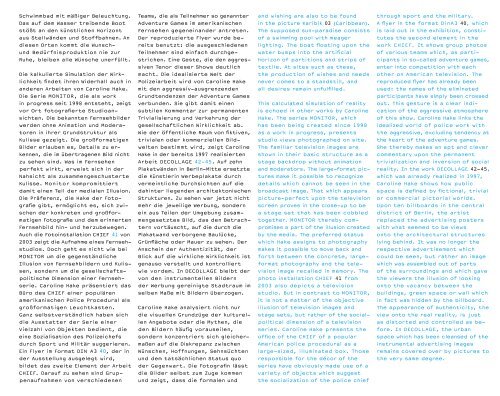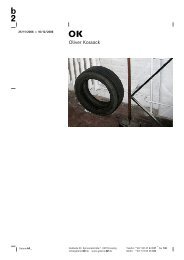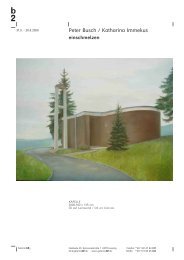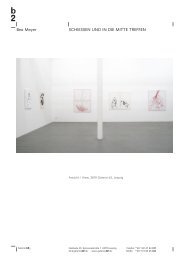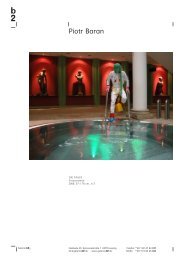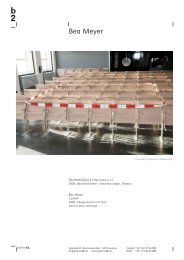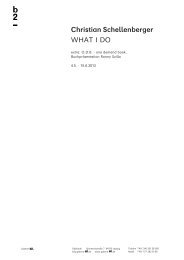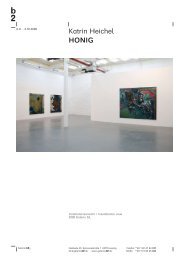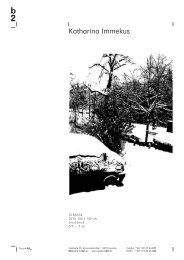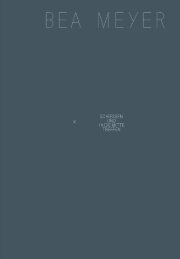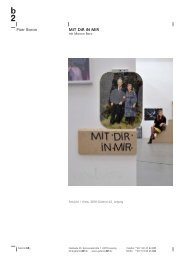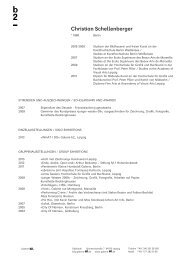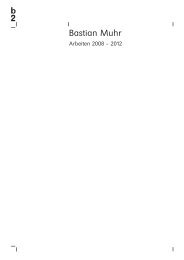Erfolgreiche ePaper selbst erstellen
Machen Sie aus Ihren PDF Publikationen ein blätterbares Flipbook mit unserer einzigartigen Google optimierten e-Paper Software.
Schwimmbad mit mäßiger Beleuchtung.<br />
Das auf dem Wasser treibende Boot<br />
stößt an den künstlichen Horizont<br />
aus Stellwänden und Stoffbahnen. An<br />
diesen Orten kommt die Wunsch-<br />
und Bedürfnisproduktion nie zur<br />
Ruhe, bleiben alle Wünsche unerfüllt.<br />
Die kalkulierte Simulation der Wirklichkeit<br />
findet ihren Widerhall auch in<br />
anderen Arbeiten von <strong>Caroline</strong> <strong>Hake</strong>.<br />
Die Serie MONITOR, die als work<br />
in progress seit 1998 entsteht, zeigt<br />
vor Ort fotografierte Studioansichten.<br />
Die bekannten Fernsehbilder<br />
werden ohne Animation und Moderatoren<br />
in ihrer Grundstruktur als<br />
Kulisse gezeigt. Die großformatigen<br />
Bilder erlauben es, Details zu erkennen,<br />
die im übertragenen Bild nicht<br />
zu sehen sind. Was im Fernsehen<br />
perfekt wirkt, erweist sich in der<br />
Nahsicht als zusammengeschusterte<br />
Kulisse. Monitor kompromittiert<br />
damit einen Teil der medialen Illusion.<br />
Die Präferenz, die <strong>Hake</strong> der Fotografie<br />
gibt, ermöglicht es, sich zwischen<br />
der konkreten und großformatigen<br />
Fotografie und dem erinnerten<br />
Fernsehbild hin- und herzubewegen.<br />
Auch die Fotoinstallation CHIEF 41 von<br />
2003 zeigt die Aufnahme eines Fernsehstudios.<br />
Doch geht es nicht wie bei<br />
MONITOR um die gegenständliche<br />
Illusion von Fernsehbildern und Kulissen,<br />
sondern um die gesellschaftspolitische<br />
Dimension einer Fernsehserie.<br />
<strong>Caroline</strong> <strong>Hake</strong> präsentiert das<br />
Büro des CHIEF einer populären<br />
amerikanischen Police Procedural als<br />
großformatigen Leuchtkasten.<br />
Ganz selbstverständlich haben sich<br />
die Ausstatter der Serie einer<br />
Vielzahl von Objekten bedient, die<br />
eine Sozialisation des Polizeichefs<br />
durch Sport und Militär suggerieren.<br />
Ein Flyer im Format DIN A3 40, der in<br />
der Ausstellung ausgelegt wird,<br />
bildet das zweite Element der Arbeit<br />
CHIEF. Darauf zu sehen sind Gruppenaufnahmen<br />
von verschiedenen<br />
Teams, die als Teilnehmer so genannter<br />
Adventure Games im amerikanischen<br />
Fernsehen gegeneinander antreten.<br />
Der reproduzierte Flyer wurde bereits<br />
benutzt: die ausgeschiedenen<br />
Teilnehmer sind einfach durchgestrichen.<br />
Eine Geste, die den aggressiven<br />
Tenor dieser Shows deutlich<br />
macht. Die idealisierte Welt der<br />
Polizeiarbeit wird von <strong>Caroline</strong> <strong>Hake</strong><br />
mit den aggressiv-ausgrenzenden<br />
Grundtendenzen der Adventure Games<br />
verbunden. Sie gibt damit einen<br />
subtilen Kommentar zur permanenten<br />
Trivialisierung und Verkehrung der<br />
gesellschaftlichen Wirklichkeit ab.<br />
Wie der öffentliche Raum von fiktiven,<br />
trivialen oder kommerziellen Bildwelten<br />
bestimmt wird, zeigt <strong>Caroline</strong><br />
<strong>Hake</strong> in der bereits 1997 realisierten<br />
Arbeit DECOLLAGE 42-45. Auf zehn<br />
Plakatwänden in Berlin-Mitte ersetzte<br />
die Künstlerin Werbeplakate durch<br />
vermeintliche Durchsichten auf die<br />
dahinter liegenden architektonischen<br />
Strukturen. Zu sehen war jetzt nicht<br />
mehr die jeweilige Werbung, sondern<br />
ein aus Teilen der Umgebung zusammengesetztes<br />
Bild, das den Betrachtern<br />
vortäuscht, auf die durch die<br />
Plakatwand verborgene Baulücke,<br />
Grünfläche oder Mauer zu sehen. Der<br />
Anschein der Authentizität, der<br />
Blick auf die wirkliche Wirklichkeit ist<br />
genauso verstellt und kontrolliert<br />
wie vordem. In DECOLLAGE bleibt der<br />
von den instrumentellen Bildern<br />
der Werbung gereinigte Stadtraum im<br />
selben Maße mit Bildern überzogen.<br />
<strong>Caroline</strong> <strong>Hake</strong> analysiert nicht nur<br />
die visuellen Grundzüge der kulturellen<br />
Angebote oder die Mythen, die<br />
den Bildern häufig vorauseilen,<br />
sondern konzentriert sich gleichermaßen<br />
auf die Diskrepanz zwischen<br />
Wünschen, Hoffnungen, Sehnsüchten<br />
und dem tatsächlichen Status quo<br />
der Gegenwart. Die Fotografin lässt<br />
die Bilder selbst zum Zuge kommen<br />
und zeigt, dass die formalen und<br />
and wishing are also to be found<br />
in the picture Karibik 03 (Caribbean).<br />
The supposed sun-paradise consists<br />
of a swimming pool with meager<br />
lighting. The boat floating upon the<br />
water bumps into the artificial<br />
horizon of partitions and strips of<br />
textile. At sites such as these,<br />
the production of wishes and needs<br />
never comes to a standstill, and<br />
all desires remain unfulfilled.<br />
This calculated simulation of reality<br />
is echoed in other works by <strong>Caroline</strong><br />
<strong>Hake</strong>. The series MONITOR, which<br />
has been being created since 1998<br />
as a work in progress, presents<br />
studio views photographed on site.<br />
The familiar television images are<br />
shown in their basic structure as a<br />
stage backdrop without animation<br />
and moderators. The large-format pictures<br />
make it possible to recognize<br />
details which cannot be seen in the<br />
broadcast image. That which appears<br />
picture-perfect upon the television<br />
screen proves in the close-up to be<br />
a stage set that has been cobbled<br />
together. MONITOR thereby compromises<br />
a part of the illusion created<br />
by the media. The preferred status<br />
which <strong>Hake</strong> assigns to photography<br />
makes it possible to move back and<br />
forth between the concrete, largeformat<br />
photography and the television<br />
image recalled in memory. The<br />
photo installation CHIEF 41 from<br />
2003 also depicts a television<br />
studio. But in contrast to MONITOR,<br />
it is not a matter of the objective<br />
illusion of television images and<br />
stage sets, but rather of the socialpolitical<br />
dimension of a television<br />
series. <strong>Caroline</strong> <strong>Hake</strong> presents the<br />
office of the CHIEF of a popular<br />
American police procedural as a<br />
large-sized, illuminated box. Those<br />
responsible for the décor of the<br />
series have obviously made use of a<br />
variety of objects which suggest<br />
the socialization of the police chief<br />
through sport and the military.<br />
A flyer in the format DinA3 40, which<br />
is laid out in the exhibition, constitutes<br />
the second element in the<br />
work CHIEF. It shows group photos<br />
of various teams which, as participants<br />
in so-called adventure games,<br />
enter into competition with each<br />
other on American television. The<br />
reproduced flyer has already been<br />
used: the names of the eliminated<br />
participants have simply been crossed<br />
out. This gesture is a clear indication<br />
of the aggressive atmosphere<br />
of this show. <strong>Caroline</strong> <strong>Hake</strong> links the<br />
idealized world of police work with<br />
the aggressive, excluding tendency at<br />
the heart of the adventure games.<br />
She thereby makes an apt and clever<br />
commentary upon the permanent<br />
trivialization and inversion of social<br />
reality. In the work DECOLLAGE 42-45,<br />
which was already realized in 1997,<br />
<strong>Caroline</strong> <strong>Hake</strong> shows how public<br />
space is defined by fictional, trivial<br />
or commercial pictorial worlds.<br />
Upon ten billboards in the central<br />
district of Berlin, the artist<br />
replaced the advertising posters<br />
with what seemed to be views<br />
onto the architectural structures<br />
lying behind. It was no longer the<br />
respective advertisement which<br />
could be seen, but rather an image<br />
which was assembled out of parts<br />
of the surroundings and which gave<br />
the viewers the illusion of looking<br />
onto the vacancy between the<br />
buildings, green space or wall which<br />
in fact was hidden by the billboard.<br />
The appearance of authenticity, the<br />
view onto the real reality, is just<br />
as distorted and controlled as before.<br />
In DECOLLAGE, the urban<br />
space which has been cleansed of the<br />
instrumental advertising images<br />
remains covered over by pictures to<br />
the very same degree.


